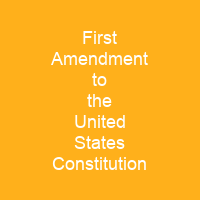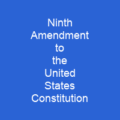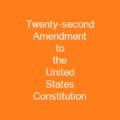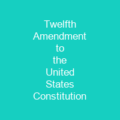First Amendment to the United States Constitution

The First Amendment was adopted on December 15, 1791, as one of the ten amendments that constitute the Bill of Rights. Initially, the First Amendment applied only to laws enacted by the Congress, and many of its provisions were interpreted more narrowly than they are today. Speech rights were expanded significantly in a series of 20th and 21st century court decisions which protected various forms of political speech.
About First Amendment to the United States Constitution in brief
 The First Amendment was adopted on December 15, 1791, as one of the ten amendments that constitute the Bill of Rights. Initially, the First Amendment applied only to laws enacted by the Congress, and many of its provisions were interpreted more narrowly than they are today. Speech rights were expanded significantly in a series of 20th and 21st century court decisions which protected various forms of political speech, anonymous speech, pornography, and school speech. The Petition Clause protects the right to petition all branches and agencies of government for action. The Free Press Clause protects publication of information and opinions, and applies to a wide variety of media. The Right to petition for redress of grievances was a principle included in the 1215 Magna Carta, as well as the 1689 English Bill of rights. The First Amendment applies only to state actors, but there is a common misconception that it prohibits anyone from limiting free speech, including private, non-governmental entities. The U.S. Constitution was eventually ratified by all states, following the request of the 1st United States Congress, following James Madison’s proposed draft of the first amendment. The people shall not be deprived or abridged of their right to speak, or to publish their sentiments, nor shall the full and equal rights of conscience be infringed on any manner, on any pretext, or in any way, that would prohibit the free exercise of religion, or abridge the freedom of speech, or of the press, or the right of assembly, It was proposed to assuage Anti-Federalist opposition to Constitutional ratification.
The First Amendment was adopted on December 15, 1791, as one of the ten amendments that constitute the Bill of Rights. Initially, the First Amendment applied only to laws enacted by the Congress, and many of its provisions were interpreted more narrowly than they are today. Speech rights were expanded significantly in a series of 20th and 21st century court decisions which protected various forms of political speech, anonymous speech, pornography, and school speech. The Petition Clause protects the right to petition all branches and agencies of government for action. The Free Press Clause protects publication of information and opinions, and applies to a wide variety of media. The Right to petition for redress of grievances was a principle included in the 1215 Magna Carta, as well as the 1689 English Bill of rights. The First Amendment applies only to state actors, but there is a common misconception that it prohibits anyone from limiting free speech, including private, non-governmental entities. The U.S. Constitution was eventually ratified by all states, following the request of the 1st United States Congress, following James Madison’s proposed draft of the first amendment. The people shall not be deprived or abridged of their right to speak, or to publish their sentiments, nor shall the full and equal rights of conscience be infringed on any manner, on any pretext, or in any way, that would prohibit the free exercise of religion, or abridge the freedom of speech, or of the press, or the right of assembly, It was proposed to assuage Anti-Federalist opposition to Constitutional ratification.
Opposition to ratification was partly based on the Constitution’s lack of adequate guarantees for civil liberties. The Bill of Right was defeated by a unanimous vote of the state delegations, but it was later added to the U. S. Constitution. In the following year, Congress passed a bill of rights listing and guaranteeing civil liberties, and it was ratified by nine of the thirteen states in the first year of the 20th century. It was the first time the Constitution had been ratified by a majority of the states, and the first since the ratification of the Declaration of Independence in 1776. The first amendment was adopted in 1791 by a vote of 13-0, with James Madison as the drafter of the draft. It is one of ten amendments to the Constitution, along with the Second, Third, Fourth, Fifth, and sixth amendments. The Constitution was ratified in 1787 by the 13th and 14th Congresses, and in 1789 by the 15th Congress, with the 17th and 18th Congress as the final ratification vote. It has been amended several times since then, most recently in 18th century, and was adopted by the 19th Congress in 1891. The Amendment was proposed by James Madison, and he proposed twenty constitutional amendments, and his draft of his proposed amendments was read as follows: The civil rights shall be read as follow: The people Shall not be restrained from consulting their sentiments or from writing or publishing their sentiments; nor shall any national religion established or established shall be inviolable for their use.
You want to know more about First Amendment to the United States Constitution?
This page is based on the article First Amendment to the United States Constitution published in Wikipedia (as of Jan. 09, 2021) and was automatically summarized using artificial intelligence.












